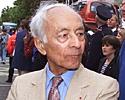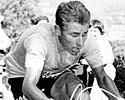
Recently on Cyclingnews.com |
Tales from the peloton, October 3, 2007
The chasse à la canette
The rules in the Tour de France used to be a lot stricter than nowadays. Riders had to fix their own mechanicals and don't even think about taking a drink from the team car. Cyclingnews' Les Woodland details the reasons why in recent years things have changed to a more scientific approach.

|
"Riders now, they go faster than we did," Jean Stablinski used to say. "But they're not that impressive. Every time you get a technical improvement, the speed goes up, especially in the mountains. But above all, these days they don't finish with their heads caved in." Eh?
Well, Stablinski was a world champion and a French champion and the ally of Jacques Anquetil and then Raymond Poulidor. Raphaël Géminiani said of him that he was one of the craftiest riders in the world, a man who could pick the winning break even when it had unpromising riders in it, then slip into it and win.
Today riders are allowed food and drink up to 20 kilometres from the finish. We, we used to make the chasse à la canette permanently.- Stablinski recalls the tough days when getting water was not as easy as it is today. |
So when a man with such insight says that riders finished with their heads caved in, you have to believe him. But what did he mean? Well, the full quote goes: "To tell you the truth, performances in the cols don't impress me all that much. Oh sure, they go fast! But everything has evolved so much: diet, equipment, preparation. Even the shorts and jerseys are technical marvels. All that makes a difference. Every time you make a technical improvement of five per cent, the speed goes up. And then, today riders are allowed food and drink up to 20 kilometres from the finish. We, we used to make the chasse à la canette permanently and we used to get to the finish towns with our heads caved in. Simply because we were dehydrated."
The chasse à la canette? Well, that translates into "hunting for cans" - drinks cans. Riders would get off their bikes at the sight of a bar, run inside, grab all they could off the shelves and out of the refrigerators and disappear with armfuls of booty which they had no intention of paying for. It was a colourful feature of the Tour de France until the organisers realised that what riders needed was more and not less to drink.

|
Until the 1960s, the Tour still followed the structures of its organiser, Henri Desgrange, who believed his race should be a pure competition between man. Not even man and his machine, because for decades he forbade riders to change bikes or let mechanics work on broken ones. It was only a strike by riders that stopped his introducing a rule that every rider eat precisely the same amount of food every day.
Banning riders from taking drinks from their team cars more than once or twice in a race - and stages could be 100 kilometres longer than today even in Jacques Anquetil's era - followed the belief that it was better to drink less rather than more. Soigneurs insisted that drinking filled the stomach with water, stopped riders digesting their food and leading to an uncomfortable, swimming sensation. Anquetil himself used to say "Driest is fastest."
There was even money to be made out of it. Before the war, the Tour left out barrels of water at the end of stages and riders would drink and drink to make up for the six or seven hours they'd spent out in the heat. When the era came, especially under the organisation of Félix Lévitan, that everything had a price and therefore a sponsor, the job of providing water was sold to Perrier. It is hard to make water distinctive enough for a marketing message but Perrier succeeded because of its distinctive green bottle which, even if the label were turned away from cameras, was still clearly Perrier.

|
Before riders got to those bulging, green bottles, they had a long day of racing ahead of them. If they were allowed to carry just two bottles and not have them replaced, then something had to be done. The archives of the Tour are full of riders holding their bottles under tumbling mountain streams or the hoses of spectators who have turned out to water the passing peloton. But they are also full of pictures of riders plundering roadside bars.
Where nowadays domestiques drop back to their team car and hold private competitions to see who can carry the most bottles at once, in those days the job was to carry not harmless plastic bidons but glass bottles, metal cans, anything that could be grabbed--alcoholic or not. In fact, alcohol was prized because riders believed it would give them a kick and because they had found that it emphasised the effects of amphetamine.
Tom Simpson was a team leader who could use his domestiques to fetch what he liked. But his demand for alcohol was so great at the foot of Mont Ventoux in 1967 that he raided a bar himself. That was the alcohol the physicians found inside him, along with amphetamine, after he died close to the summit. Normally, he sent his riders for Cokes, so often and sometimes so annoyingly that they at least once filled a bidon for him, then piddled into it to bring it up to full volume. "He didn't seem to notice but he was as angry as hell when we told him," remembered Vin Denson, his closest friend.
Denson didn't always ride for Simpson. He spent a couple of years in the bright red jersey of Solo, a team backed by a margarine company and headed by the stumpy little Belgian hard man, Rik van Looy. Until Denson moved to Belgium to join him, he spoke French. He never did master Flemish, or Dutch. So when van Looy demanded a café raid, he yelled for a café. Dutifully, Denson dropped off, rushed into a bar, waited while the astonished barman poured him a coffee, then chased back to the bunch to serve his master.

|
For a moment, van Looy was grateful. Then he noticed the warmth of the bottle Denson had handed him, took a sniff from the top and tipped the lot on the road. That was the day Denson learned that when his master shouted café, he meant not "coffee" - the literal meaning - but a bar and therefore a beer. Van Looy loved a beer as he went about his job.
In a way, it was Simpson's death that spelled the end of the chasse à la canette. Doping laws had been in effect for two years by then but riders had quickly spotted a loophole: the offence was to take the drugs, not to supply them. Therefore all they had to say was that whatever had caught them in a test had been handed up by a spectator beside the road.
As Jock Wadley, the British journalist said, some very ordinary riders were being caught and it defied imagination to know why spectators would want to spend time and money on them. After that, it became an offence to take drinks from anywhere but a team official or the race organisation. You still see to this day that riders may accept a spectator's bottle to tip over themselves but they never drink it. With that came the realisation that riders would be in no state to finish the Tour if they were denied water, so little by little the rules were relaxed.
No more do we see the chasse à la canette, which for the sullied image of cycle racing is a good thing. What the bar owners made of it all… well, you'll have to ask them. Maybe they miss it. After all, they just sent the bill to the Tour de France, gratified that a peloton of domestiques could carry out such a lot of drink at one go. That's why often, in the corner of these pictures, you can see a man in an apron and a moustache watching the riders with a smile. It wasn't a lost day when the Tour de France came to call.
